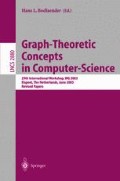Abstract
This paper is concerned with the graph searching game: we are given a graph containing a fugitive (or lost) entity or item; the goal is to clear the edges of the graph, using searchers; an edge is clear if it cannot contain the searched entity, contaminated otherwise. The search numbers(G) of a graph G is the smallest number of searchers required to “clear” G. A search strategy is monotone (m) if no recontamination ever occurs. It is connected (c) if the set of clear edges always forms a connected subgraph. It is internal (i) if the removal of searchers is not allowed (i.e., searchers can not jump but only move along the edges). The difficulty of the “connected” version and of the “monotone internal” version of the graph searching problem comes from the fact that none of these problems is minor closed for arbitrary graphs, as opposed to all known variants of graph searching. We prove that there is a unique chain of inequalities linking all the search numbers above. More precisely, for any graph G, s(G) = is(G) = ms(G) ≤ mis(G) ≤ cs(G) = ics(G) ≤ mcs(G) = mics(G). The first two inequalities can be strict. Motivated by the fact that connected graph searching and monotone internal graph searching are both minor closed in trees, we provide a complete characterization of the set of trees that can be cleared by a given number of searchers. In fact, we show that, in trees, there is exactly one obstruction for monotone internal search, as well as for connected search, and this obstruction is the same for the two problems. This allows us to prove that, for any tree T, mis(T)= cs(T) and cs(T) ≤ 2 s(T) − 2, using that ics(T)=mcs(T). This implies that there are only two different search numbers, and these search numbers differ by a factor of 2 at most.
Access this chapter
Tax calculation will be finalised at checkout
Purchases are for personal use only
Preview
Unable to display preview. Download preview PDF.
References
Barrière, L., Flocchini, P., Fraigniaud, P., Santoro, N.: Capture of an intruder by mobile agents. In: 14th ACM Symp. on Parallel Algorithms and Architectures (SPAA 2002), Winnipeg, August 10-13 (2002)
Barrière, L., Fraigniaud, P., Santoro, N., Thilikos, D.M.: Connected and Internal Graph Searching. Technical Report LSI-02-58-R, Universitat Politècnica de Catalunya, Barcelona, Spain (2002), http://www.lsi.upc.es/~sedthilk
Bienstock, D.: Graph searching, path-width, tree-width and related problems. DIMACS Series in Disc. Maths. and Theo. Comp. Sc. 5, 33–49 (1991)
Bienstock, D., Seymour, P.: Monotonicity in graph searching. Journal of Algorithms 12, 239–245 (1991)
Breisch, R.: An intuitive approach to speleotopology. Southwestern Cavers VI(5), 72–78 (1967)
Ellis, J., Sudborough, H., Turner, J.: The vertex separation and search number of a graph. Information and Computation 113(1), 50–79 (1994)
Fellows, M., Langston, M.: On search, decision and the efficiency of polynomial time algorithm. In: 21st ACM Symp. on Theory of Computing (STOC 1989), pp. 501–512 (1989)
Fomin, F., Thilikos, D.M.: On the monotonicity of games generated by symmetric submodular functions. Discrete Applied Mathematics (to appear)
Franklin, M., Galil, Z., Yung, M.: Eavesdropping games: a graph theoretic approach to privacy in distributed systems. Journal of the ACM 47(2), 225–243 (2000)
Lapaugh, A.: Recontamination does not help to search a graph. Journal of the ACM 40(2), 224–245 (1993)
Linial, N., Magen, A., Saks, M.: Trees and Euclidian metrics. In: 30st ACM Symp. on Theory of Computing (STOC 1998), pp. 169–175 (1998)
Matousek, J.: On embedding trees into uniformly convex Banach spaces. Israelian Journal of Mathematics 114, 221–237 (1999)
Makedon, F., Sudborough, H.: Minimizing width in linear layouts. In: Díaz, J. (ed.) ICALP 1983. LNCS, vol. 154, pp. 478–490. Springer, Heidelberg (1983)
Megiddo, N., Hakimi, S., Garey, M., Johnson, D., Papadimitriou, C.: The complexity of searching a graph. Journal of the ACM 35(1), 18–44 (1988)
Parsons, T.: Pursuit-evasion in a graph. In: Theory and Applications of Graphs. Lecture Notes in Mathematics, pp. 426–441. Springer, Heidelberg (1976)
Parsons, T.: The search number of a connected graph. In: 9th Southeastern Conference on Combinatorics, Graph Theory and Computing, Utilitas Mathematica, pp. 549–554 (1978)
Robertson, N., Seymour, P.: Graph minors — A survey. In: Anderson, I. (ed.) Surveys in Combinatorics, pp. 153–171. Cambridge University Press, Cambridge (1985)
Seymour, P., Thomas, R.: Graph searching, and a min-max theorem for treewidth. Jour. Combin. Theory, Ser. B 58, 239–257 (1993)
Skodinis, K.: Computing optimal linear layouts of trees in linear time. In: Paterson, M. (ed.) ESA 2000. LNCS, vol. 1879, pp. 403–414. Springer, Heidelberg (2000)
Takahashi, A., Ueno, S., Kajitani, Y.: Minimal acyclic forbidden minors for the family of graphs with bounded path-width. Discrete Mathematics 127(1-3), 293–304 (1994)
Thilikos, D.: Algorithms and obstructions for linear-width and related search parameters. Discrete Applied Mathematics 105, 239–271 (2000)
Author information
Authors and Affiliations
Editor information
Editors and Affiliations
Rights and permissions
Copyright information
© 2003 Springer-Verlag Berlin Heidelberg
About this paper
Cite this paper
Barrière, L., Fraigniaud, P., Santoro, N., Thilikos, D.M. (2003). Searching Is Not Jumping. In: Bodlaender, H.L. (eds) Graph-Theoretic Concepts in Computer Science. WG 2003. Lecture Notes in Computer Science, vol 2880. Springer, Berlin, Heidelberg. https://doi.org/10.1007/978-3-540-39890-5_4
Download citation
DOI: https://doi.org/10.1007/978-3-540-39890-5_4
Publisher Name: Springer, Berlin, Heidelberg
Print ISBN: 978-3-540-20452-7
Online ISBN: 978-3-540-39890-5
eBook Packages: Springer Book Archive

